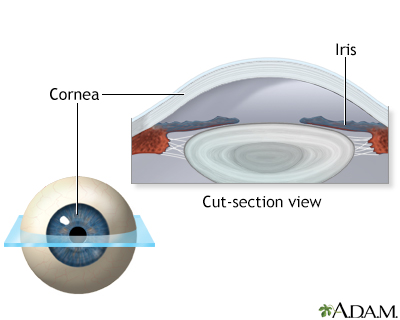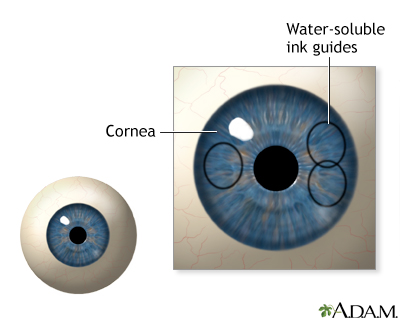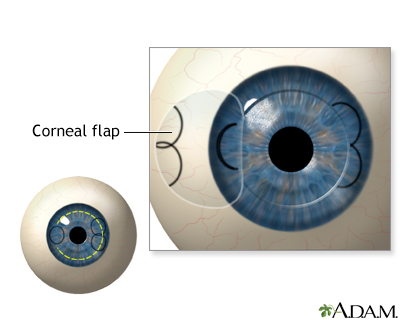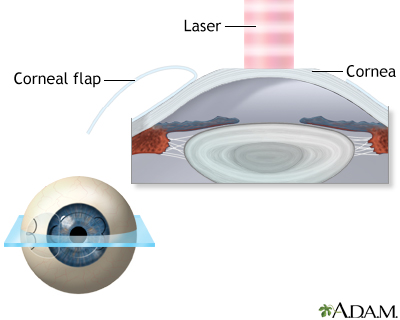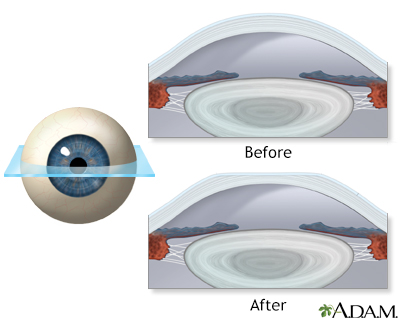Farsightedness
HyperopiaFarsightedness is having a harder time seeing objects that are close than things that are far away.
The term is often used to describe the need for reading glasses as you get older. However, the correct term for that condition is presbyopia. Although related, presbyopia and hyperopia (farsightedness) are different conditions. People with hyperopia will also develop presbyopia with age.
Causes
Farsightedness is the result of the visual image being focused behind the retina rather than directly on it. It may be caused by the eyeball being too small or the focusing power being too weak. It can also be a combination of both.
Retina
The retina is the light-sensitive layer of tissue at the back of the eyeball. Images that come through the eye's lens are focused on the retina. Th...

Farsightedness is often present from birth. However, children have a very flexible eye lens, which helps make up for the problem. As aging occurs, glasses or contact lenses may be needed to correct the vision. If you have family members who are farsighted, you are also more likely to become farsighted.
Symptoms
Symptoms include:
-
Aching eyes
Aching eyes
Pain in the eye may be described as a burning, throbbing, aching, or stabbing sensation in or around the eye. It may also feel like you have a forei...
 ImageRead Article Now Book Mark Article
ImageRead Article Now Book Mark Article -
Blurred vision when looking at close objects
Blurred vision
There are many types of eye problems and vision disturbances, such as: Halos Blurred vision (the loss of sharpness of vision and the inability to see...
 ImageRead Article Now Book Mark Article
ImageRead Article Now Book Mark Article - Crossed eyes (strabismus) in some children
- Eye strain
- Headache while reading
Mild farsightedness may not cause any problems. However, you may need reading glasses sooner than people who do not have this condition.
Exams and Tests
A general eye exam to diagnose farsightedness may include the following tests:
- Eye movement testing
- Glaucoma testing
- Refraction test
- Retinal examination
-
Slit-lamp examination
Slit-lamp examination
The slit-lamp examination looks at structures that are at the front of the eye.
 ImageRead Article Now Book Mark Article
ImageRead Article Now Book Mark Article -
Visual acuity
Visual acuity
The visual acuity test is used to determine the smallest letters you can read on a standardized chart (Snellen chart) or a card held 20 feet (6 meter...
 ImageRead Article Now Book Mark Article
ImageRead Article Now Book Mark Article - Cycloplegic refraction, a refraction test done with the eyes dilated
This list is not all-inclusive.
Treatment
Farsightedness is easily corrected with glasses or contact lenses. Surgery is available for correcting farsightedness in adults. This is an option for those who do not wish to wear glasses or contacts.
Outlook (Prognosis)
The outcome is expected to be good.
Possible Complications
Farsightedness can be a risk factor for glaucoma and crossed eyes.
Glaucoma
Glaucoma is a group of eye conditions that can damage the optic nerve. This nerve sends the images you see to your brain. Most often, optic nerve da...

When to Contact a Medical Professional
Contact your health care provider or eye doctor if you have symptoms of farsightedness and you have not had a recent eye exam.
Also, contact your provider if vision begins to get worse after you have been diagnosed with farsightedness.
See a provider right away if you think you have farsightedness and you suddenly develop the following symptoms:
- Severe eye pain
- Eye redness
- Decreased vision
References
Cioffi GA, Liebmann JM. Diseases of the visual system. In: Goldman L, Cooney KA, eds. Goldman-Cecil Medicine. 27th ed. Philadelphia, PA: Elsevier; 2024:chap 391.
Diniz D, Irochima F, Schor P. Optics of the human eye. In: Yanoff M, Duker JS, eds. Ophthalmology. 6th ed. Philadelphia, PA: Elsevier; 2023:chap 2.2.
Holmes JM, Kulp MT, Dean TW, et al. A randomized clinical trial of immediate versus delayed glasses for moderate hyperopia in children 3 to 5 years of age. Am J Ophthalmol. 2019;208:145-159. PMID: 31255587 pubmed.ncbi.nlm.nih.gov/31255587/.
-
Visual acuity test - illustration
Visual acuity tests may be performed in many different ways. It is a quick way to detect vision problems and is frequently used in schools or for mass screening. Driver license bureaus often use a small device that can test the eyes both together and individually.
Visual acuity test
illustration
-
Normal, nearsightedness, and farsightedness - illustration
Normal vision occurs when light is focused directly on the retina rather than in front or behind it. A person with normal vision can see objects clearly near and faraway. Nearsightedness results in blurred vision when the visual image is focused in front of the retina, rather than directly on it. It occurs when the physical length of the eye is greater than the optical length. For this reason, nearsightedness often develops in the rapidly growing school-aged child or teenager, and progresses during the growth years, requiring frequent changes in glasses or contact lenses. A nearsighted person sees near objects clearly, while objects in the distance are blurred. Farsightedness is the result of the visual image being focused behind the retina rather than directly on it. It may be caused by the eyeball being too small or the focusing power being too weak. Farsightedness is often present from birth, but children can often tolerate moderate amounts without difficulty and most outgrow the condition. A farsighted person sees faraway objects clearly, while objects that are near are blurred.
Normal, nearsightedness, and farsightedness
illustration
-
Normal vision - illustration
Normal vision occurs when light is focused directly on the retina rather than in front or behind it.
Normal vision
illustration
-
Lasik eye surgery - series - Normal anatomy
Presentation
-
Farsighted - illustration
A person who is farsighted has the ability to see objects clearly far away but not see as clearly close-up. Farsightedness is often present from birth. If you have family members who are farsighted, you are also more likely to become farsighted.
Farsighted
illustration
-
Visual acuity test - illustration
Visual acuity tests may be performed in many different ways. It is a quick way to detect vision problems and is frequently used in schools or for mass screening. Driver license bureaus often use a small device that can test the eyes both together and individually.
Visual acuity test
illustration
-
Normal, nearsightedness, and farsightedness - illustration
Normal vision occurs when light is focused directly on the retina rather than in front or behind it. A person with normal vision can see objects clearly near and faraway. Nearsightedness results in blurred vision when the visual image is focused in front of the retina, rather than directly on it. It occurs when the physical length of the eye is greater than the optical length. For this reason, nearsightedness often develops in the rapidly growing school-aged child or teenager, and progresses during the growth years, requiring frequent changes in glasses or contact lenses. A nearsighted person sees near objects clearly, while objects in the distance are blurred. Farsightedness is the result of the visual image being focused behind the retina rather than directly on it. It may be caused by the eyeball being too small or the focusing power being too weak. Farsightedness is often present from birth, but children can often tolerate moderate amounts without difficulty and most outgrow the condition. A farsighted person sees faraway objects clearly, while objects that are near are blurred.
Normal, nearsightedness, and farsightedness
illustration
-
Normal vision - illustration
Normal vision occurs when light is focused directly on the retina rather than in front or behind it.
Normal vision
illustration
-
Lasik eye surgery - series - Normal anatomy
Presentation
-
Farsighted - illustration
A person who is farsighted has the ability to see objects clearly far away but not see as clearly close-up. Farsightedness is often present from birth. If you have family members who are farsighted, you are also more likely to become farsighted.
Farsighted
illustration
Review Date: 7/23/2024
Reviewed By: Linda J. Vorvick, MD, Clinical Professor, Department of Family Medicine, UW Medicine, School of Medicine, University of Washington, Seattle, WA. Also reviewed by David C. Dugdale, MD, Medical Director, Brenda Conaway, Editorial Director, and the A.D.A.M. Editorial team.






